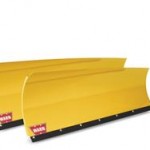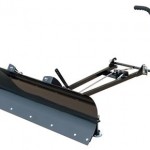Are you thinking about adding a snow plow to your ATV or side by side?
Great idea. Whether you’re looking to more efficiently remove snow from your driveway, or perhaps make some extra money during the winter season, matching the right plow with your machine and understanding your options is a good first step.
Choosing the best snow plow blade for your application doesn’t have to be a complicated. We reached out to our friends at Warn to get their expert take on some of these options.
 Blade size and shape
Blade size and shape
Snow plow blades are categorized by size, shape and material.
Straight blades are the most common. But you may also consider tapered blades—commonly found on large, commercial road-clearing trucks, V-blades, or multi-position plows.
Snow plows are measured in inches by their width, and they commonly range from 48 inches to 72 inches.
According to Warn, the general rule of thumb is that you want your plow blade to be about six inches wider than your ATV or UTV. This allows the snow to clear the tires when fully rotated.
“Quads under 450cc usually can’t handle the force of the snow that a 54-inch or 60-inch blade can handle, so they are best with a 50-inch or smaller,” said Kyle Pfenning, a technical customer service representative at Warn. “ATVs with [cubic centimeters] of 450 to 750 generally are best with a 54-inch. 750 and up are usually able to handle a 60-inch.”
Poly vs. Steel
Snow plow blades are typically made of steel or high-density polyethylene—a type of plastic often found in construction applications, including outdoor furniture, commercial and residential decking, and drainage pipe.
Both materials have their fans and detractors. The poly blades are a little heavier than their steel blade counterparts when not in use. However, while plowing, users generally experience the poly blades being lighter than steel because the snow sticks to the steel while more easily sliding off the poly blade.
The poly blades’ color will fade over time with prolonged ultraviolet light exposure, but because they are a uniform color throughout, scratches won’t show. The poly blades are typically more impact resistant, and are resistant to rust and corrosion—though you should be washing your plow blade after each use anyway, particularly if you’re exposing it to salt.
In the end, the poly vs. steel debate comes down to personal choice.
Mounting
You will need a vehicle-specific mount to attach your plow to your quad or side by side. Ensuring the plow you want has mounting compatibility with your machine will be one of the first and most-important things you do.
Along with mounting, you’ll have to consider what lifting mechanism you’ll want to use to move your plow.
Your options include:
1. Using an existing winch, or adding a winch.
Tech tip: Synthetic winch rope is available in short lengths, designed specifically for plowing. Consider adding this short piece to protect your primary winch cable from the up-and-down wear and tear. The winch’s pull rating is not really a factor for lifting a snow plow, however Warn officials recommend getting a winch hefty enough to pull your vehicle out of any sticky situation in which you might find yourself during non-plowing season.
2. Using a manual lift system.
3. Using an electric lift system.
4. Using a hydraulic lift system. These are pretty expensive.
Push Tubes
Push tubes are required for all ATV and UTV plow applications. Push tubes are the component that attaches the plow mounting kit to your plow blade assembly. There are mounting points on all of the components.
Warn offers different models of push tubes—ones designed for light-duty use, and their ProVantage line for heavy duty use. Warn also makes UTV-specific push tubes to accommodate the typically larger blades used on side by sides.
Other Plow Components and Accessories
Other components to consider for your plow include things like roller fairleads to ward off fraying, plow markers to help you clearly identify your snow plow’s clearance, plow flaps which prevent snow from falling over the blade, and plow side walls, which help control the direction of the snow by walling off the outside of your plow blade.
Snow plows are the perfect antidote for the winter blues. When the weather outside gets frightful, the last place you’re going to want to be is by some delightful fire. You’re going to be out there defying nature, and bringing joy to the entire neighborhood—even if that neighborhood is just you and a bunch of acreage. Happy plowing.



what brand of snowplow is pictured in this article ? I am curiuous because I need to find mount bracket for one thanks for any help
The yellow one? That’s from Warn. You can see plenty of more ATV snow plow blade options here.
…
And if you’re looking for a way to mount it to your ATV/UTV, click here.